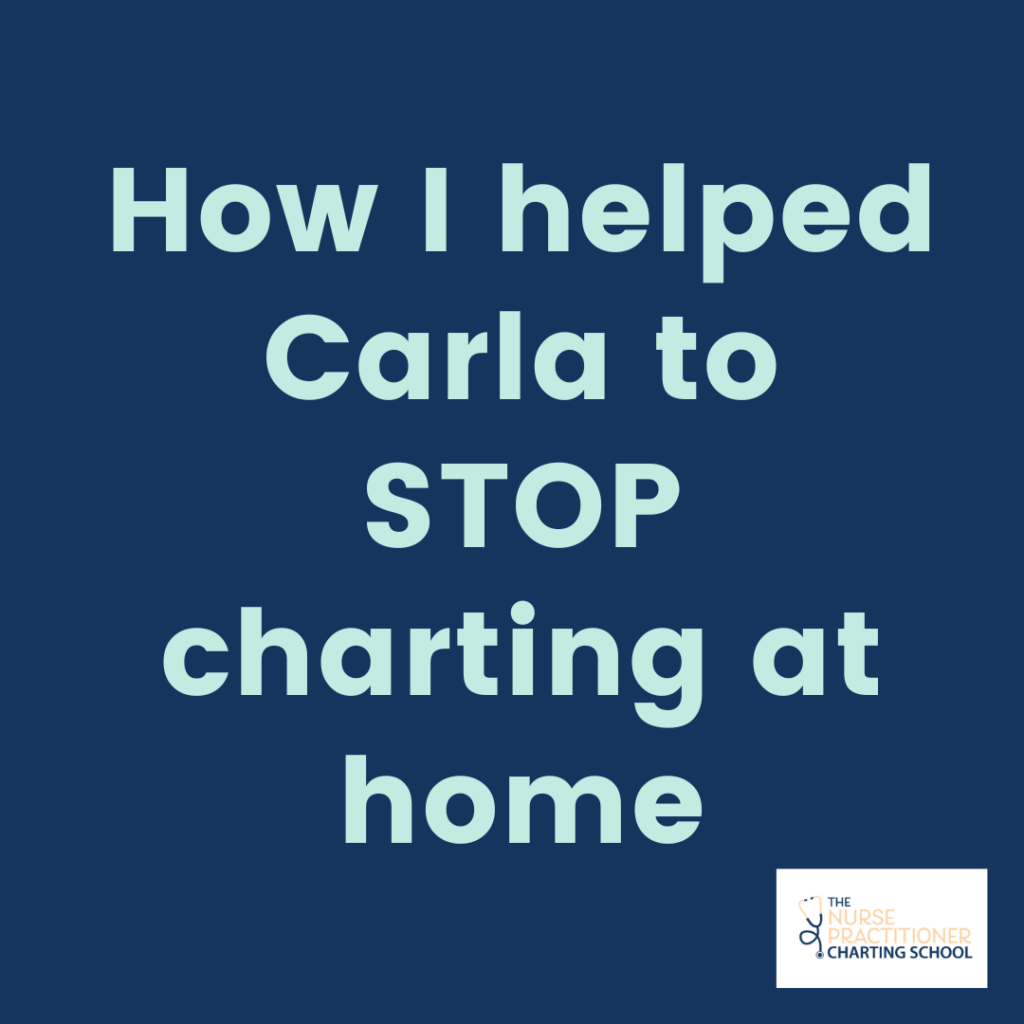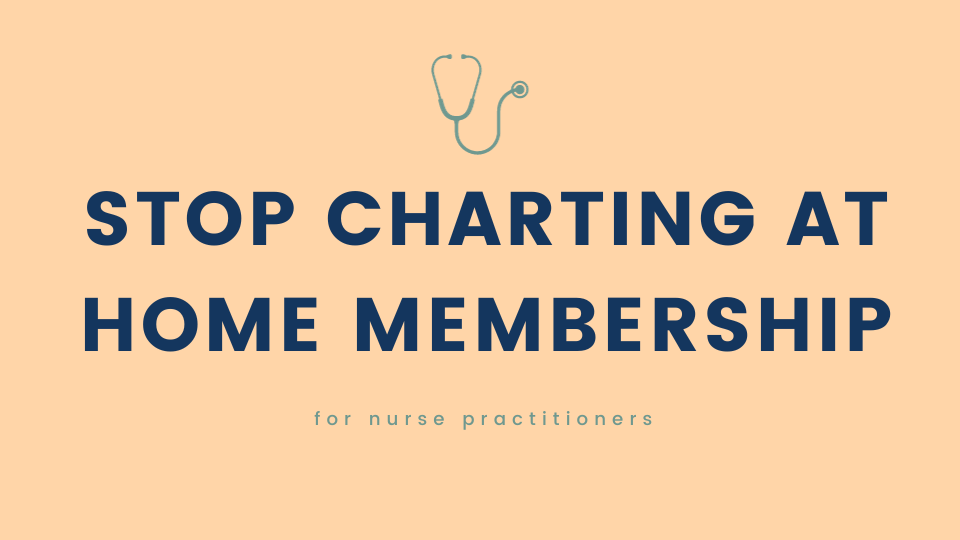Meet Carla, a family nurse practitioner and mom of two kids! Carla has been at her current primary care job for the past four years.
Carla contacted me for help because she was sick and tired of charting at home. Carla was feeling burned out and considered leaving her current role.
She was seeing about 12 patients a day and constantly running behind. She struggled with a backlog of open charts (30+). The night before the charts were required to be signed, she would stay up till 1:00am just trying to catch up!
Carla was tired of putting her children and spouse in the backburner became she was always stressed about the excessive charting. She was completely exhausted and ready to leave her current role.
Does this sound familiar?
Carla struggled with charting at home
When I first started working with Carla, I reassured her that she is not alone. I have helped hundreds of nurse practitioners in her shoes that are struggling with the charting at home. Then we sat down and took a deep dive into her current practice. Carla evaluated what was the most significant cause of her charting and time management struggles.
One of the things that came to mind was a lack of boundaries with patients. Carla was allowing these patients to address multiple complaints during a visit. She wanted to talk to them for longer than the scheduled appointment which caused her to constantly be running behind during the day.
Carla also noted she struggled with procrastination. She reported her mind became so overwhelmed that she began to shut down and would struggle to do the chart note.
Carla also struggled with over charting, creating “note bloat.” She realized she needed to create problem, focused notes that were much quicker to write.
Carla admits to not focusing on using smart phrases or templates. She had a few a smart/dot phrases that she used, but did not take the time to improve or create more.
Carla’s plan to STOP charting at home
Once we identified Carla’s charting struggles, we were able to create a plan. I reminded Carla that small actionable steps and compound to make a tremendous impact.
Set boundaries with patients
I encouraged Carla to set boundaries of her patients. Setting boundaries is a way to protect our time as nurse practitioners. But it also holds the patient accountability to take their health seriously. When nurse practitioners are in an appointment with the patient, it is impossible to address 6+ complaints. The nurse practitioner should encourage the patient to focus on the top two concerns. The APRN can also provide resources to learn more about the conditions that were not addressed in the appointment.
Need help setting those boundaries? I recommend using phrases such as, “What are the two most important things you would like to discuss today.” And when patient brings up multiple issues during a visit reply, “I want to give this issue the proper time and attention, please schedule an appointment to further evaluate your concerns.”
Setting boundaries helps to protect the time and energy of the nurse practitioner which can help them avoid charting at home!
Avoid procrastination
As far as the feelings of procrastination, Carla took some time to reflect how the procrastination was negatively impacting her life. She realized how much time and energy she was taking away from her family because she was catching up on charting at home. She realized that if she could make an effort to avoid procrastination she wouldn’t have to chart at home or sacrifice time with her kids.
She started to focus on the task at hand. She began putting her full attention on charting and eliminated any distractions. This helped Carla avoid procrastination and STOP charting at home!
I also had Carla implement my favorite charting tip, finish the chart note right after the patient encounter. This charting tab really helps with overall productivity and time management. Carla started out by implementing this charting tip for acute visits as these were typically easier to finish. She made a lot of progress by getting the acute notes signed right away.
Problem focused chart notes
Carla put more effort into creating problem focused chart notes. She removed any unnecessary information, improving the “note boat.” She used phrases instead of full sentences which took less time to document.
Carla also made sure the review of systems and physical exam were “medically necessary.” She avoided charting too much information which really helped create short & sweet, straight to the point chart notes. Not only did it take less time and energy to create problem focused notes but helped Carla to avoid charting at home!
Using smart phrases and templates
Carla also spent some time fixing her smart phrases and creating templates. While this took more up front time, Carla found that I saved a lot of time in the long run.
Carla used phrases form the Comprehensive List of Smart Phrases. These phrases are ready-to-use so all Carla had to do was copy and paste into her charting system. She could then update for her specific practice. She no longer had to type out the same phrases again and again. This really helped Carla save time charting and avoid charting at home!
***If you would like to access these ready-to-use smart phrases, be sure to check out the Comprehensive List of Smart Phrases.
Carla’s results!
Carla and I worked together for several weeks and really focused on making small, attainable habit it changes. And I was blown away by her progress! Carla was able to STOP charting at home!
Carla no longer had a backlog of open charts. She told me what an amazing feeling it was to have her evenings free and not have to stay up late signing off notes. Carla was also able to significantly improve staying caught up during her workday.
By signing the chart note off right after the patient visit, Carla only had a couple notes to finish over her late lunch break. She reports her afternoon went much smoother and would have anywhere from 0 to 3 open charts at the end of the day. This was a significant improvement from the 10+ open chart notes she used to have!
Carla states she has had much more time and energy for her kids in the evening. She notes improvement in her mental, physical, and emotional health. She loves that she got her time back to do the activities that help her rest and recharge.
Carla made so many improvements in the short amount of time. And I couldn’t be more proud!
Do you want to be like Carla?
If you would like the same information and support Carla received, be sure to join the STOP Charting at Home Membership!
This annual membership will show you the easily-to-implement charting tips and tricks to help you make those small, attainable habit changes. The membership offers group coaching calls where you can ask Erica D the Nurse Practitioner Charting Coach specific questions about your practice. You will also be a part of a community of equally burned-out nurse practitioners ready to hold you accountable!
So if you are like Carla:
- Sick and tired of charting at home,
- Wishing you had more time with your family,
- Craving the energy to actually do the self-care you know you need,
- Needing support and accountability,
- And wanting to get your life back,
Join the STOP Charting at Home Membership!

Erica D the NP is a family nurse practitioner and The Nurse Practitioner Charting Coach. Erica helps nurse practitioners STOP charting at home! Erica created The Nurse Practitioner Charting School to be the one stop for all documentation resources created specifically for nurse practitioners. Learn more at www.npchartingschool.com
Follow on Facebook: The Nurse Practitioner Charting SchoolAnd on Instagram: @npchartingschool
Free training: 4 charting tips to help nurse practitioners get their time back! Sign up here!




